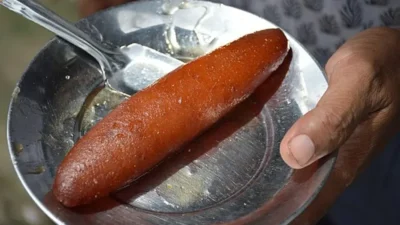Introduction

Belonging to the revered groups of sweet dishes in Bengal, this sweet categorically enjoys some acquired fame across the country, mainly revolving in and around the eastern and central parts of both India as well as Bangladesh. In fact, when anyone talks or sits to share stories of and about Langcha, they are bound to mention the stop named Shaktigarh, located in the town of Burdwan. This is regarded as the primary hometown of this beloved syrup filled mishti.
Origin
The back story behind this famous sweet is quite well documented in the famous novel Roopmanjari by Narayan Sanyal. The sweet, now, might, frequently be connected or associated to Burdwan’s Shaktigarh. But, it by itself has much of a long history which links right upto the birthplace in Krishnanagar, Nadia. Shaktigarh has also earned their fame from the tale of some leper. This man used to be fond of preparing sweets for the royal home. This story dates back straight to 1890s.

Later, it was Krishnachandra Ray’s favourite daughter from the family in Krishnanagar, who got married to the prince from Burdwan, continuing the thread of the tale. It is believed that on conceiving, this princess was much naturally brought home by Krishnachandra Ray. Here, she begun to seriously lose much of her appetite from pregnancy very randomly. This escalated for serious medical intervention. The princess now expressed her desire to eat some mishti, which she faintly recalled eating back in Burdwan. She could not name the mishti but described it as some very dark and deeply fried sweet that had to be soaked in some sugar syrup. It surprisingly turned out that some sweetmaker, who was a leper, from Burdwan, was the one who created this delicacy. Soon, her descriptions were regarded of and the unnamed Moira from Burdwan got summoned to Krishnanagar. The rest is history that we all relish today !
Motifs / Process Specifics
Traditionally, this famous mishti known as lyangcha is typically made from some form of solidified milk. However, due to absence or unavailability, often as a replacement, milk powder can be used. The sweet dish Lyangcha is thus made from the core components of flour and milk powder. This flour as well as milk powder typically gets very evenly mixed thoroughly. This is done with the help of both soda and water. It is actuallly made into some solid dough. Then, ghee gets added upon at regular intervals. They are mixed well and is usually kept untouched. This dough is then divided into muktiple cylinder shapes with hand, which are further deep-fried. A browny crust gets formed that is allowed to turn very stiff. They are then boiled into pans of sugary syrups. Sometimes, in the end, for flavouring, cold rose or elaichi and nutties, cashews pieces are sprinkled before serving. Usualy, when kept untouched for some hours, they solidify into hard pieces. These then become very soft as well as juicy, because of the syrup, being all ready to get served hot or normal on plates.

Challenges faced
The dough, in the very first place, needs being very properly and delicately kneaded in order to achieve absolutely the right proportion of consistency. This can neither be too sticky or be too dry. Addition of ghee needs attention as too little or too much can very easily spoil the taste. The brown crust making is a challenge in itself. It needs to be deep fried but in a manner that when put to mouth, its very juicy. The shape is a typical one and obviously needs consistency and care. Also, the chhana used. The previous day chhana, when tricked on plates, can be heavy on the stomach. It is upon the reputation of the shop or individual and their honesty absolutely.

Cultural importance / relevance
The Government of West Bengal gifted Lyangcha its GI tag owing to the rich cultural history in regards to its origin. The royal families of Bengal are believed to have once sponsored and been the baton bearing behind the sweet tooth that the state proudly boasts of having. This is a generational craft practiced down the hierarchy which makes it even special. Efforts are being made to make it internationally available. Thanks to the food delivery apps who helps in spreading Lyangcha across geographies.

Contemporary Status
Lyangcha has successfully found its soft place in much of modern times dessert platter offerings. While it still remains as major traditional sweet, with a rich past, it is also available now in several forms all across India as well as the world. The Indian based sweet shops, located in the regions of Europe as well as the US, offer this Lyangcha to their diaspora, that ensures that the legacy is carried on.
Conclusion
Shaktigarh in Burdwan is a neat 1.5-hour car ride from the Kolkata city. Shaktigarh typically has about 20-30 lyangcha shops located on both the sides of the busy road. Every place sells Lyangcha, with people ranging from farmers to celebrities, enjoying the delicacy alike. Lyangcha is such kind of a sweet which is well accepted in the regions of Jharkhand , Orissa, Tripura and Assam. Mostly , Agartala serves lyangcha as a major side dish with breakfast chronicles, an eye witness to the same. The GI tag of lyangcha makes it possible for the people in the West to serve the delicacy as dessert more. In fact, Indian desserts are found to be pretty well received too which is a good news for us. The fact that such an epic and historical sweet dish has kept up its legacy to the day is what makes it more special regardless.
References
https://itiriti.wordpress.com/2011/11/03/biography-of-langcha-burdwan-or-krishnanagar/




